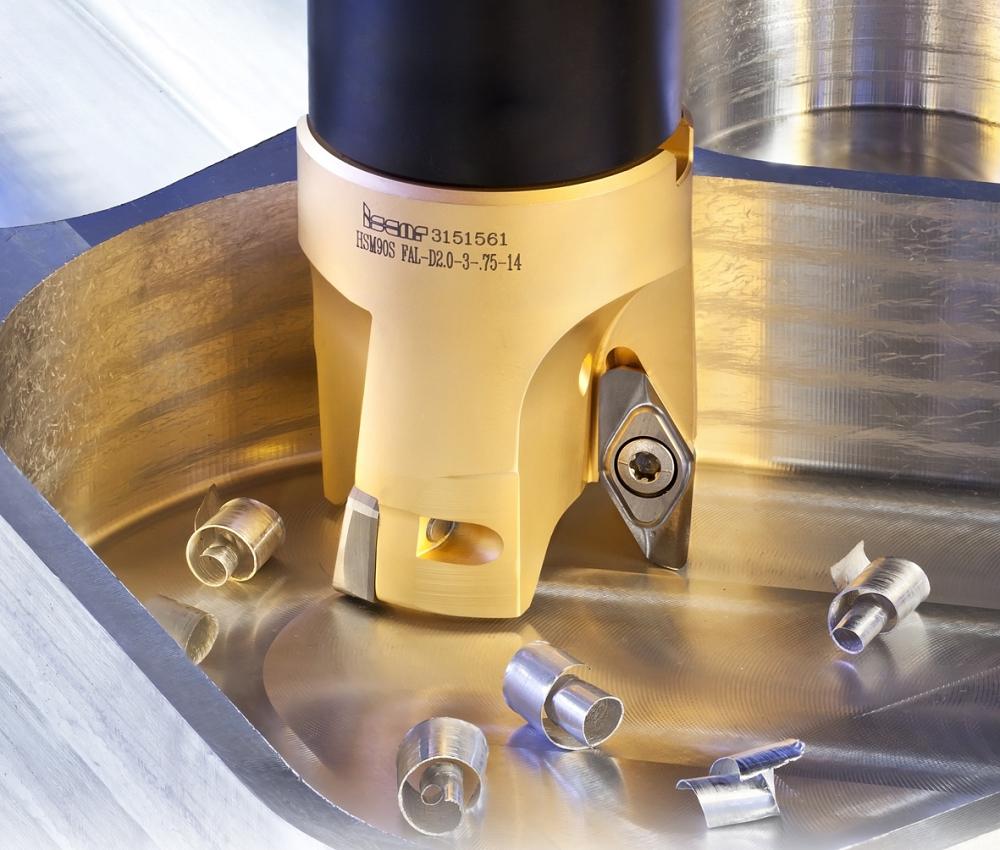- FMA
- The Fabricator
- FABTECH
- Canadian Metalworking
Maximize Your Metal Removal Rates
High-speed milling of aluminum requires proper tooling choice
- By Reuven Shapir
- July 21, 2016

To reduce the cost of producing aerospace parts, which often involves removing up to 90 per cent of the original workpiece material, higher metal removal rates need to be achieved.
The milling of aluminum parts for the aerospace industry is a machining process that requires the removal of large volumes of material by rough milling. As a result, semifinishing and finishing operations for these parts are characterized by the creation of narrow walls and thin bases that lead to limited workpiece rigidity.
Although aluminum is a soft material with relatively good machinability, because of the large size of many aerospace parts and their multiple pockets, milling normally involves the removal of more than 90 per cent of the original workpiece material. This typically results in long process involving extended semifinishing and finish milling times.
Throughout the world many parts are still produced on gantry machines that have large horizontal tables and vertical spindles, a machine tool arrangement that often causes chip evacuation difficulties. Because these machines often have limited spindle power and speed capabilities, limited control results in low feeds, which lead to long production times.
Improving Metal Removal Rate
Aluminum removal rates on typical gantry machines typically reach up to 2,000 cc/min., and semifinishing and finishing operations also are very time-consuming because of control and spindle speeds limits.
To reduce cost per unit, manufacturers need to increase metal removal rates for roughing and achieve faster table feeds for semifinishing and finishing operations. To help manufacturers realize these aims, machine tool builders developed 5-axis machines that have high spindle speeds (30,000 RPM and higher) combined with increased power.
The first-generation machines typically were rated at 60 kW; later, machine power was increased to 70 kW. Now 80- to 120-kW machines are common. These advanced 5-axis machines often have coolant-through-spindle capability, resulting in much improved coolant and chip evacuation, an important factor in milling deep pockets.
When roughing with spindle speeds of 30,000 RPM at 60-kW power in reliable production conditions, a manufacturer can achieve a metal removal rate of 4,000 cc/min. on aluminum. Similarly, a metal removal rate of 5,000 cc/min. is achieved with 80 kW of power. Machines with an updated, reinforced spindle with 120 kW of power are able to remove 8,000 cc/min. of aluminum.
The emergence and continuing evolution of modern 5-axis machines with enhanced capabilities have challenged tooling manufacturers to develop new tools with the ability to function effectively in applications with high cutting data.
Rough milling tools typically have an indexable insert diameter of 50 mm, and the machine’s spindle power dictates the number of inserts.
Spindle Power (kW) Number of Teeth (z)
60 2
80 3
120 (reinforced) 4
After rough milling operations are complete, a machine capable of 30,000 RPM with fast CNC axis controls of up to 60,000 mm/min. enables solid-carbide end mills to be used to significantly reduce milling times for both semifinishing and finishing operations.
Solid-carbide end mills with a 25-mm diameter are commonly used to complete roughing operations within contours where a tool diameter of 50 mm is too large.
In extreme conditions, modern 5-axis machines enable high metal removal rates. To realize the full productive potential of these machines, however, manufacturers need to use the latest cutting tools.
These cutting tools need to be able to resist intense cutting and centrifugal forces to guarantee a reliable process and to ensure good chip evacuation while moving large volumes of chips when milling deep pockets. Also, to prevent built-up edge (BUE) and to enable milling in these extreme conditions, inserts with a ground, sharp, very positive edge geometry, combined with polished rake, should be used.
Tools that combine excellent performance, good chip evacuation, low cutting forces, and little vibration generation create time savings when used on modern, powerful machines with high spindle speeds and fast feeds.
Reuven Shapir is industry manager, aerospace marketing division, Iscar Tools, 905-829-9000, www.iscar.ca.
subscribe now


Keep up to date with the latest news, events, and technology for all things metal from our pair of monthly magazines written specifically for Canadian manufacturers!
Start Your Free SubscriptionAbout the Author
- Industry Events
MME Winnipeg
- April 30, 2024
- Winnipeg, ON Canada
CTMA Economic Uncertainty: Helping You Navigate Windsor Seminar
- April 30, 2024
- Windsor, ON Canada
CTMA Economic Uncertainty: Helping You Navigate Kitchener Seminar
- May 2, 2024
- Kitchener, ON Canada
Automate 2024
- May 6 - 9, 2024
- Chicago, IL
ANCA Open House
- May 7 - 8, 2024
- Wixom, MI




















